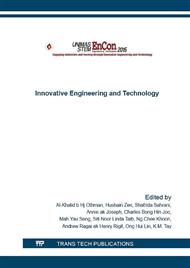p.71
p.78
p.87
p.94
p.102
p.111
p.119
p.126
p.135
Electrical Resistivity of Cement Based Materials
Abstract:
Electrical resistivity (ER) of cement based materials (CBM) is an important measurement that indirectly relates to the durability of CBM. This study investigates the correlation between ER of CBM namely concrete with water-to-cement (w/c). As one of CBM hydration parameters w/c is an important parameter that contributes to variations of ER. The results of this study showed that different w/c can be used as indication for the setting characteristics as well as the pore structure of the concrete. ER is obtained by applying current into the concrete and measuring the response voltage during concrete hydration period of 28 days. Two aspects were also being considered in this study: (i) test specimen size and (ii) spacing between the probes. Results show the direct correlation between ER and test specimen sizes and spacing between the probes.
Info:
Periodical:
Pages:
102-107
Citation:
Online since:
April 2016
Keywords:
Price:
Сopyright:
© 2016 Trans Tech Publications Ltd. All Rights Reserved
Share:
Citation:


